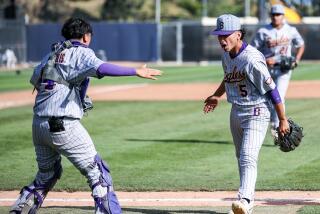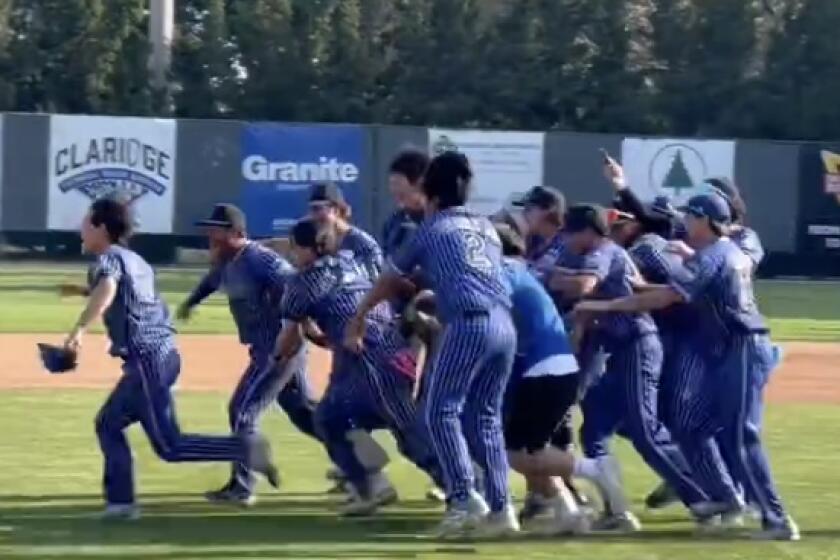Addition of Alderson Sits Well With Towers
Kevin Towers, the San Diego Padre general manager, cast himself into baseball’s steroid furor by revealing he’d had dark suspicions about Ken Caminiti, and was called with a handful of fellow executives before the House Government Reform Committee.
Steroids, as it turned out, were not Caminiti’s ruin. Five months after his friend had died in a drug-ridden quarter of the Bronx, Towers would sit before Congress to take questions about the steroid era, as a face on the Caminiti experience.
He was there because of his link to Caminiti, who had admitted to steroid use in the 1990s, including his MVP season with the Padres, and Towers was told the interrogation would be pointed. When the Major League Baseball lawyers briefed its baseball panel before the hearing, Towers had two requests -- not to be positioned between Commissioner Bud Selig and players’ union head Don Fehr, where the focus of the hearing would lie, and to be sat beside Sandy Alderson, baseball’s executive vice president, whom he admired.
Towers was 34 when he became general manager of the Padres almost a decade before. He was hired to right an organization that had floated between awful, mediocre and other shades of yellow, orange and brown for all but a couple of years of its history, and his early go coincided with Alderson’s final seasons as president of the Oakland Athletics. He liked Alderson and admired what he’d done for those A’s in the late ‘80s and early ‘90s. When Alderson left the A’s for the commissioner’s office in 1998, he and Towers again found a common interest: Towers became head of baseball’s scouting committee and Alderson held interesting opinions on player evaluation.
So, given the choice of being the Selig-Fehr middleman during a Capitol grilling or sitting to Alderson’s left, Towers chose familiarity.
“He’s the guy I wanted to be next to,” Towers said this week between innings of a game against the Dodgers. “As stressful a situation as that was, I felt most comfortable next to him.”
Four weeks later, he heard that Padre owner John Moores had spoken to Alderson about taking over the club’s baseball operations. A week after that, the confirmation arrived: Alderson was made chief executive, given an ownership stake, and would replace President Dick Freeman as Towers’ conduit to Moores.
Towers is under contract through 2007. The club holds an option for 2008. Manager Bruce Bochy is in the final season of his contract; an offer of two more years was withdrawn when Moores began the process of hiring Alderson. Freeman, who oversaw the Padres’ move into Petco Park after moving the Pittsburgh Pirates into PNC Park three years before, previously held the title of CEO.
So the Padres, chosen by many to win the National League West, find themselves in organizational flux three weeks into the season, ill-fit to their own ballpark, dealing with injuries and slow starts, and around .500 after finishing six games behind the Dodgers a season ago.
Towers and Bochy, great friends and a Batman-and-Robin tandem in San Diego for 10 years, say the addition of Alderson -- who, with Grady Fuson and Tony La Russa, once assembled a powerhouse A’s team -- could only help an organization that had had five consecutive losing years before last season. Fuson currently serves as Towers’ assistant.
And Moores insists the hire has as much to do with his own desire to spend less time in the day-to-day operations of the club as with any dissatisfaction with the state of the Padres’ baseball operations.
When the Alderson hire was announced, Towers said, he heard from more than a few acquaintances.
“They asked, ‘You all right? What does this mean?’ ” he said. “But I don’t have an ego. I’ve never worn the title I have on my sleeve. To be successful, you have to be a team.... I still consider myself a young general manager. I hope I can learn from him. He’s walked in my shoes before.
“When I first heard it, the first thing I thought was, ‘Wow, we’re a better organization.’ Never once did I look at this as negative. You have to have confidence in your abilities, which I do.”
Alderson’s course has been debated as well. Many believe he held aspirations to succeed Selig even before he joined Selig’s staff in 1998. When Selig had his contract extended through 2009, and with Bob DuPuy and Rob Manfred dealing with many of the critical issues in the commissioner’s office, Alderson perhaps found a better way to spend the coming five years.
Friends of Alderson’s say he had a desire to run a team again, and that he is no less -- or more -- likely to rise to commissioner from the Padres’ front office. Alderson, who inquired about becoming president of the Dodgers when Frank McCourt purchased the team, said Selig’s status had no impact on his decision to resign.
“I didn’t go to New York [in ‘98] with that in mind,” he said. “I didn’t leave Oakland with that in mind. I’m flattered my name is mentioned from time to time. [But] I really haven’t thought about that as a realistic option or probability.”
But ambition floats, and what better place than the little ballpark by the sea, with a sharp general manager who wears loafers and no socks, and a manager who could do with more suitably quick corner outfielders and more pitching but has always done the best with what he has had. They’re the Padres, but they don’t have to be forever.
DePodesta’s Inspiration
At about the time Towers became general manager in San Diego, Paul DePodesta was fresh out of Harvard and working for the Baltimore Stallions of the Canadian Football League.
He played baseball and football in college and had charted a career course in football, either in management or coaching.
According to DePodesta, he had stepped into the office of the Stallions’ chief financial officer, Aric Holsinger, one afternoon. On one wall, Holsinger had a shelf. On the shelf, a stack of baseball media guides. In the stack, the A’s guide.
DePodesta leafed through the pages and stopped at Alderson’s biography. Like DePodesta, Alderson was Ivy League educated: Dartmouth undergrad, Harvard law.
He recalled thinking, “Maybe that’s something I could do.”
By the spring of 1996, DePodesta had joined the A’s. He became Billy Beane’s right-hand man and, eight years later, became general manager of the Dodgers.
“He’s the person who made me think it was possible,” DePodesta said of Alderson.
Alderson, among the first to employ objective statistics to the subjective arena of player evaluation, was not aware of the connection until Friday.
“That’s a great story,” he said. “I have a lot of respect for Paul.”
While in Oakland, DePodesta heard all of the Alderson stories, of building teams and grooming Beane and winning that championship. And now Alderson is here, a couple of hours down I-5, a few games down the National League West standings.
“I’m thrilled for Sandy because I think the world of him and know it was something he was looking for, to get back to an individual club,” DePodesta said.
That he returned, “within our own division,” DePodesta said with a smile, “that makes it a little mixed.”
As for Alderson’s becoming the next commissioner, DePodesta sighed and thought through his response. How to put this, exactly.
“I think,” he said, “he represents the game extremely well.”
A Clear Message
If you were wondering, as I was, about the wisdom of the Padres’ honoring Caminiti last week, an e-mail from Padre broadcaster Tim Flannery, who knew Caminiti well and remains close with the family Caminiti left behind, will provide clarity:
“It was a perfect night for his children and wife and the fans that needed to express some feelings, maybe for closure. My little girl spent the night with Cammy’s oldest (13) and my wife was with Nancy [Caminiti’s widow] all night after as well. When they brought the girls on the field and gave them a baseball signed, and played a video, that little 13-year-old wept from the bottom of her soul. I saw it and I cried on the air out in center field. There was no mixed message, my 13-year old said afterwards, and I brought her on the radio yesterday to say it. Kendall and her sisters hear nothing else except the bad from media. The ceremony gave them some great pain, but they were blown away by the love of the people at the park. My daughter held her and wept afterwards with her. They are heartbroken and every parent that was there saw it. And every child saw what drugs can do to a family. My 13-year-old got it and in the eyes of the children there were no mixed messages. Just in the eyes of the people who need to have everything black and white in their own minds, not looking at another point of view. It was a perfect night, a healing night, and the children all got it.”
More to Read
Get our high school sports newsletter
Prep Rally is devoted to the SoCal high school sports experience, bringing you scores, stories and a behind-the-scenes look at what makes prep sports so popular.
You may occasionally receive promotional content from the Los Angeles Times.






